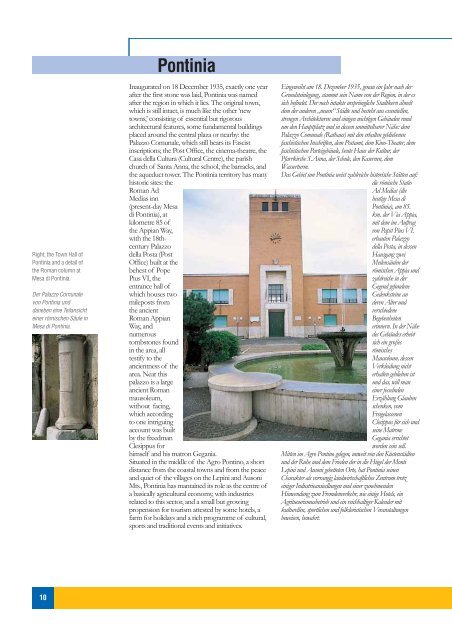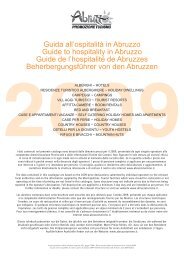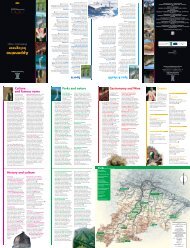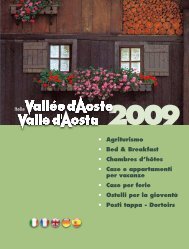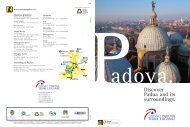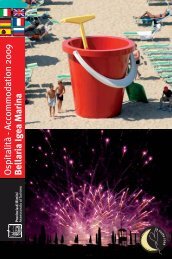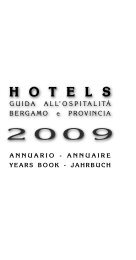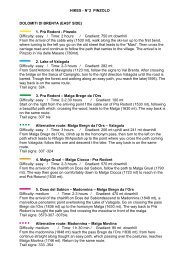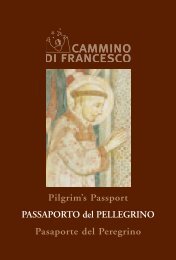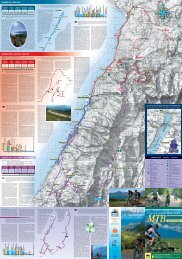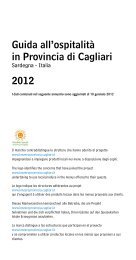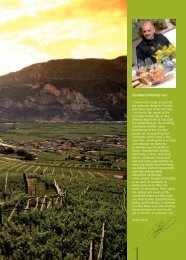Create successful ePaper yourself
Turn your PDF publications into a flip-book with our unique Google optimized e-Paper software.
Right, the Town Hall of<br />
Pontinia and a detail of<br />
the Roman column at<br />
Mesa di Pontinia.<br />
Der Palazzo Comunale<br />
von Pontinia und<br />
daneben eine Teilansicht<br />
einer römischen Säule in<br />
Mesa di Pontinia.<br />
10<br />
Pontinia<br />
Inaugurated on 18 December 1935, exactly one year<br />
after the first stone was laid, Pontinia was named<br />
after the region in which it lies. The original town,<br />
which is still intact, is much like the other ‘new<br />
towns,’ consisting of essential but rigorous<br />
architectural features, some fundamental buildings<br />
placed around the central plaza or nearby: the<br />
Palazzo Comunale, which still bears its Fascist<br />
inscriptions; the Post Office, the cinema-theatre, the<br />
Casa della Cultura (Cultural Centre), the parish<br />
church of Santa Anna, the school, the barracks, and<br />
the aqueduct tower. The Pontinia territory has many<br />
historic sites: the<br />
Roman Ad<br />
Medias inn<br />
(present-day Mesa<br />
di Pontinia), at<br />
kilometre 85 of<br />
the Appian Way,<br />
with the 18thcentury<br />
Palazzo<br />
della Posta (Post<br />
Office) built at the<br />
behest of Pope<br />
Pius VI, the<br />
entrance hall of<br />
which houses two<br />
mileposts from<br />
the ancient<br />
Roman Appian<br />
Way, and<br />
numerous<br />
tombstones found<br />
in the area, all<br />
testify to the<br />
ancientness of the<br />
area. Near this<br />
palazzo is a large<br />
ancient Roman<br />
mausoleum,<br />
without facing,<br />
which according<br />
to one intriguing<br />
account was built<br />
by the freedman<br />
Clesippus for<br />
himself and his matron Gegania.<br />
Situated in the middle of the Agro Pontino, a short<br />
distance from the coastal towns and from the peace<br />
and quiet of the villages on the Lepini and Ausoni<br />
Mts., Pontinia has mantained its role as the centre of<br />
a basically agricultural economy, with industries<br />
related to this sector, and a small but growing<br />
propension for tourism attested by some hotels, a<br />
farm for holidays and a rich programme of cultural,<br />
sports and traditional events and initiatives.<br />
Eingeweiht am 18. Dezember 1935, genau ein Jahr nach der<br />
Grundsteinlegung, stammt sein Name von der Region, in der es<br />
sich befindet. Der noch intakte ursprüngliche Stadtkern ähnelt<br />
dem der anderen „neuen“ Städte und besteht aus essentiellen,<br />
strengen Architekturen und einigen wichtigen Gebäuden rund<br />
um den Hauptplatz und in dessen unmittelbarer Nähe: dem<br />
Palazzo Comunale (Rathaus) mit den erhalten gebliebenen<br />
faschistischen Inschriften, dem Postamt, dem Kino-Theater, dem<br />
faschistischen Parteigebäude, heute Haus der Kultur, der<br />
Pfarrkirche S.Anna, der Schule, den Kasernen, dem<br />
Wasserturm.<br />
Das Gebiet um Pontinia weist zahlreiche historische Stätten auf:<br />
die römische Statio<br />
Ad Medias (die<br />
heutige Mesa di<br />
Pontinia), am 85.<br />
km. der Via Appia,<br />
mit dem im Auftrag<br />
von Papst Pius VI.<br />
erbauten Palazzo<br />
della Posta, in dessen<br />
Hausgang zwei<br />
Meilensäulen der<br />
römischen Appia und<br />
zahlreiche in der<br />
Gegend gefundene<br />
Gedenksteine an<br />
deren Alter und<br />
verschiedene<br />
Begebenheiten<br />
erinnern. In der Nähe<br />
des Gebäudes erhebt<br />
sich ein großes<br />
römisches<br />
Mausoleum, dessen<br />
Verkleidung nicht<br />
erhalten geblieben ist<br />
und <strong>das</strong>, will man<br />
einer fesselnden<br />
Erzählung Glauben<br />
schenken, vom<br />
Freigelassenen<br />
Clesippus für sich und<br />
seine Matrone<br />
Gegania errichtet<br />
worden sein soll.<br />
Mitten im Agro Pontino gelegen, unweit von den Küstenstädten<br />
und der Ruhe und dem Frieden der in die Hügel der Monti<br />
Lepini und Ausoni gebetteten Orte, hat Pontinia seinen<br />
Charakter als vorrangig landwirtschaftliches Zentrum trotz<br />
einiger Industrieansiedlungen und einer zunehmenden<br />
Hinwendung zum Fremdenverkehr, wie einige Hotels, ein<br />
Agrituourismusbetrieb und ein reichhaltiger Kalender mit<br />
kulturellen, sportlichen und folkloristischen Veranstaltungen<br />
beweisen, bewahrt.


